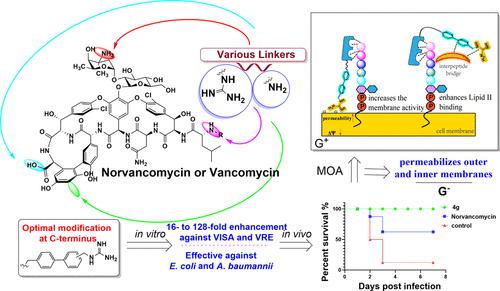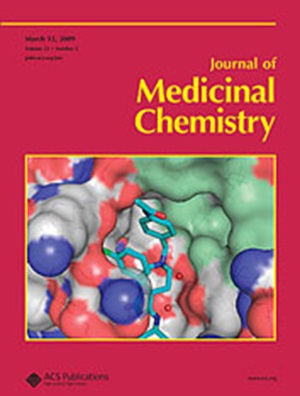Single Amine or Guanidine Modification on Norvancomycin and Vancomycin to Overcome Multidrug-Resistance through Augmented Lipid II Binding and Increased Membrane Activity
IF 6.8
1区 医学
Q1 CHEMISTRY, MEDICINAL
引用次数: 0
Abstract
Vancomycin and norvancomycin have diminished antibacterial efficacy due to acquired or intrinsic resistance from mutations in the terminal dipeptide of lipid II in Gram-positive bacteria or failure to penetrate into the periplasm in Gram-negative bacteria. Herein, we rationally designed and synthesized a series of vancomycin analogues bearing single amine or guanidine functionality, altering various linkers and modification sites, to combat the resistance. Extensive antibacterial screening was performed to delineate a comprehensive SAR. Many derivatives revitalized the activity in vitro, exhibiting a 4–128-fold or 2–16-fold enhancement against the acquired or intrinsic resistance with lower toxicity. Significantly, the optimal compound 4g demonstrated greater pharmacokinetic and pharmacodynamic profiles. Further studies uncovered additional independent and synergistic mechanisms for 4g, including the enhanced membrane activity and augmented inhibition of peptidoglycan biosynthesis via increased lipid II binding, highlighting its potential as a future lead candidate to replenish the glycopeptide antibiotic arsenal.

对诺万古霉素和万古霉素进行单胺或胍修饰,通过增强脂质 II 结合力和提高膜活性来克服多重耐药性
在革兰氏阳性菌中,万古霉素和诺万古霉素因脂质 II 的末端二肽发生突变而产生获得性或固有耐药性;在革兰氏阴性菌中,万古霉素和诺万古霉素无法渗透到细胞质周围而导致抗菌效果下降。在此,我们通过改变各种连接体和修饰位点,合理设计并合成了一系列具有单胺或胍功能的万古霉素类似物,以对抗耐药性。我们进行了广泛的抗菌筛选,以确定全面的 SAR。许多衍生物恢复了体外活性,对获得性或固有抗药性的抗性增强了 4-128 倍或 2-16 倍,毒性更低。值得注意的是,最佳化合物 4g 显示出更强的药代动力学和药效学特征。进一步的研究还发现了 4g 的其他独立和协同机制,包括增强膜活性和通过增加脂质 II 结合增强对肽聚糖生物合成的抑制作用,这突显了其作为未来补充糖肽抗生素库的主要候选药物的潜力。
本文章由计算机程序翻译,如有差异,请以英文原文为准。
求助全文
约1分钟内获得全文
求助全文
来源期刊

Journal of Medicinal Chemistry
医学-医药化学
CiteScore
4.00
自引率
11.00%
发文量
804
审稿时长
1.9 months
期刊介绍:
The Journal of Medicinal Chemistry is a prestigious biweekly peer-reviewed publication that focuses on the multifaceted field of medicinal chemistry. Since its inception in 1959 as the Journal of Medicinal and Pharmaceutical Chemistry, it has evolved to become a cornerstone in the dissemination of research findings related to the design, synthesis, and development of therapeutic agents.
The Journal of Medicinal Chemistry is recognized for its significant impact in the scientific community, as evidenced by its 2022 impact factor of 7.3. This metric reflects the journal's influence and the importance of its content in shaping the future of drug discovery and development. The journal serves as a vital resource for chemists, pharmacologists, and other researchers interested in the molecular mechanisms of drug action and the optimization of therapeutic compounds.
 求助内容:
求助内容: 应助结果提醒方式:
应助结果提醒方式:


